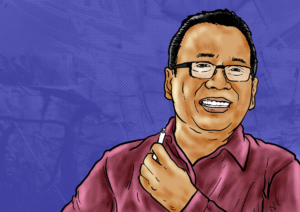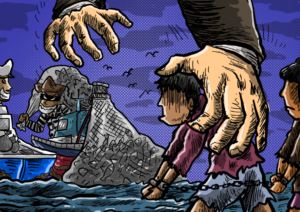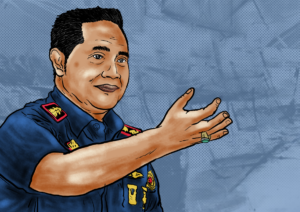The trauma from ethnic conflict in West Kalimantan haunted him. Four ethnic groups in West Kalimantan, Malay, Dayak, Chinese, and Madurese indeed hold a significant conflict record. In the article ‘Menelusuri Akar Konflik Antaretnik di Kalimantan Barat’ – searching for the root of ethnic conflicts in West Kalimantan – Arkanudin (2006) wrote the conflict mostly involved Dayak – Madurese. There were 12 incidents that involved violence between 1952 and 1999.
Usman is a Madurese. He was born and raised in Pontianak. The Dayak – Madurese conflict-affected him since he was 7 years of age. That time, the issue of riot appeared in the Sungai Jawi area, only one kilometer away from his home at Gang Nur Asyikin on HM Suwigyo street, Pontianak city.
At the same time, chaos broke in Sampit, Central Kalimantan. While in West Kalimantan, the large conflict happened in 1999 at Sambas. Those two incidents involved Madura ethnic group.
Little Usma lived with his parents and a sister. Hearing the alarming news, the whole family was restless. Tilam, his father, equipped him with a katana and asked him to take care of his mother and his sister in the house, while the father stood guard outside.
“Every time I saw my dad disappear from the front porch, I went after him,” Usman told the story in a thick Malay accent.
Fortunately, everything went well. But the daunting stories and the stereotyping continued to live inside everyone’s head. One of them was to assume that Dayak people can smell the Madurese’s whereabouts.
That was the first thing that came across his mind when Usman found out that PPKJ has Dayak members.
“You know how the Madurese when they met Dayak people. It crossed my mind if I joined this firefighting force, will I be dealing with “my kind of people” only? At the end of the day, if this is my destiny, and it will make me useful for others, I will give it a try,” he said.
The mind of this youngest of three had made up. It all started from his close relationship with Sumi – a Malay girl who had become his wife now. Seven of his in-laws are volunteers in the firefighting force.
To become a volunteer in the fire fighting force, Usman had to fight his childhood nightmares. We could say, PPKJ was his first avenue to interact with various ethnic groups. Even though the vast majority was Malay but still, Chinese, Bugis, and Dayak were part of this social movement.
His Madurese-ness was once questioned by other firefighters considering his thick Malay accent. He even took his friends home to meet his parents to convince his friends.
He needed at least a month to familiarize himself with others. Until the time of Gawai Dayak came – the annual harvest festival for Dayak tribes in West Kalimantan – and it was centralized in Pontianak, his friend Teddy took him.
That Gawai was held in Rumah Betang on Letjen Sutoyo street in South Pontianak. Usman was cold sweating in broad daylight. Especially when he entered the room to meet the Tribe Leader. He was introduced as “a friend from the firefighting force” by Teddy.
“Permission to introduce myself, Commander. I am Usman, I am a Madurese, kindly advise me,” Usman said awkwardly, surrounded by several Dayak Tribe Leaders from all over West Kalimantan.
Having Usman introduced himself in such fashion, the Tribe Leader appreciated him. He asked everyone to follow the steps of the two gentlemen: to act accordingly to their social spirit.
“Usman, if anyone from Kalimantan messes around with you, especially those from Dayak tribes, find me,” the Tribe Leader made a closure of his introduction.
Six years in the firefighting force, Usman now has many friends from various ethnicities and religions. Currently, he holds the position as the Head of Suwignyo Association of Firefighting Force (PPKS), prior to that, he spent two years in Mariana Fire Fighting Union (PPM).
“Evidently not everyone is being evil to me, many of them are a better person than I am. I had many bits of advice too. When someone gave me advice, they meant well. Eventually, I thought that there are more good people in Pontianak than the bad ones,” he said.
The existence of this private firefighting force in Pontianak started with the Chinese community in 1948, located in Siantan, North Pontianak. That area was a rubber, copra, and tengkawang mills workers’ housing area – main export commodities that are vulnerable to fire.
At least two major fire accidents in 1947 had risen the awareness of the people. Those were the fire of rubber warehouse and smokehouse owned by NV Nyan Sung that almost demolished the whole village in Parit Pekong, along the Kapuas River.
From just preparing buckets, sand, and fire extinguishers in certain spots, eventually a number of public figures pioneered by Tan Khie Ho – the manager of Liang Huat rubber mills – took the initiative to collect Rp. 20,000,- to procure two Dutch produced Fa Gerbs Kronenburg Culemborg 3,000 RPM water pump machines.
On February 13, 1949, Badan Pemadam Api Siantan (BPAS) – Siantan Fire Extinguishing Body – was established and had 50 members. This was the origin of the private firefighting force in Pontianak. The Government did have a fire fighting force too, but geographically, Pontianak is divided by the Kapuas River with Pontianak City, West Pontianak, South East Pontianak, and South Pontianak sub-Districts on one side, and East and North Pontianak on the other side. This had made it difficult for the Government’s firefighting force since they are located on the other side of the river.
Until the year 1957, BPAS had three firefighting units spread across the Siantan Hulu, Central Siantan, and Siantan Hilir sub-Districts. On July 25, 1976, Panca Bhakti Firefighting Force was established in West Pontianak. Both were under a Chinese foundation, but volunteers from various ethnicities were joining. Those who shared the common fear of fear started to join, even though the number were still small.
A huge fire at the Sudirman Market area and a long drought had made this private firefighting force more familiar to the society. Not only they extinguished the fire, during the dry seasons, but their water tanks also helped people to channel clean water. The growth of the force started with water pump machines in a wooden cart, slowly evolved to cars with large water tank capacity.
The staggering growth of this Pontianak private firefighting force happened in 2000. Up till now, at least there are 39 private firefighting forces spread all across Pontianak. Four in Mempawah, and 12 others in Kubu Raya. Some have firefighting vans, some have only one unit of motorbike. All volunteers are unpaid. Their existence is almost like a competition with the fire incidents in Pontianak, which is on average, 100 incidents annually.
“Apart from being unpaid, sacrifice is inevitable. This is the high value of our nation, mutual cooperation, and this is a direct implementation of Pancasila and Bhineka Tunggal Ika,” Ateng Tanjaya, the Head of Pontianak Firefighting Communication Forum said.
Ateng Tanjaya was the Chief of BPAS from 1984 until 1996. His nickname is “Fire Man”, and he had been involved in the firefighting world since 1971. The forum he led was established in 1980.
“When a riot broke, it was full of danger. This could mean that the ethnicity-religion-race aspects are hindering the work of firefighting force because our presence was not welcome,” this Chinese man who admitted he had no business skills said.
The trend of setting fire during a riot in Pontianak started in 1990. The fire was used to demolish opponents. The firefighting force was in a deep dilemma. They felt obliged to help the people, but on the other hand, what they were facing on the field was not fire, but for demonstration mass.
“Since then, I thought of how to handle group A, B, C. That is why I started to approach the community leaders in the society, recruiting them to be members, even if they only held an administrative position as Security Division within the Board of Governance,” he explained.
These community leaders actively involved in the field and provide security measures for all members. The network was opened with Alpha tango – his call sign within the force – through Organisasi Radio Amatir Indonesia (ORARI)/Indonesian Amateur Radio Organisation, and Radio Antar Penduduk Indonesia (RAPI)/Inter-Indonesian Society Radio. The communication channels between firefighting forces were using their frequencies.
“We recruit leaders from each village, placed them as advisors or supervisors within the organisation. So, when something delicate related to ethnicities-religions-races happened, they will be standing at the frontline. Sometimes they even arrived at the scene ahead of us and managed to control the mass,” he said.
Apart from these central figures, police force and army were also approached. Continuous coordination was conducted especially during the forest and land fire that happened frequently.
“The brotherhood with other ethnicities is used to be very limited, now it has developed, and they all hold the Pancasila values. Housing areas are getting crowded, and there is some sort of pride when we are able to help all,” he said.
The spirit to help others also serves as a double-edged sword. The scale-up growth of this private firefighting force often creates friction on the field. Not in terms of ethnicities, but more of trying to stand out at the fire scene.
As a result, a zoning system was created. Each firefighting force is responsible for its own zone. Coordination through a communication forum is prioritized, and other firefighting forces are welcome to help in the event of a difficult fire.
“If anyone wanted to help for the sake of society, they are most welcome. But if they only seek fame and popularity, they had better stay put. It will cost the society,” he said.
The volunteers of this private firefighting force now consist of many different ethnicities and religions. They make up around a thousand members, but not all are active in the field. Only those with passion and compassion survive.
“We welcome everyone, with the condition that they are willing to work without wages. We will be able to see the difference later, which ones are the real volunteers who work wholeheartedly,” he mentioned.
“On the other hand, natural disasters are predestination, and God is fair too, because disasters happened unselectively. Doesn’t matter what religion or race you are. Maybe this kind of values have made the private firefighting force grew rapidly in Pontianak,” he continued.
However, Ateng cannot deny that seeds of conflict reappeared. Especially using identity politics during the general election. During the Presidential Election, he was overwhelmed and had to put a limit in the WhatsApp Group of firefighters to reduce inter-ethnicity tension even though the atmosphere between ethnicities within the force is very liquid. Stigma and stereotyping against the Chinese ethnicity had already faded away.
“Sometimes they were joking with each other, but then someone would be offended. There were so many examples, we will keep trying to maintain the original goals of this volunteer group,” he said.
The activities of this firefighting force are not limited to fire extinguishing only. Since two years ago, every Idul Fitri evening they will drive around the city reciting the ‘takbir’. Not only the Moslem volunteers, but everyone is celebrating it.
This ritual had been held five times. Initiated by Swadesi Borneo firefighting force, the original three agendas only covered West Pontianak, their own zone, the participants were also volunteers for the respective area.
“In 2019 there were 40 firefighting forces who joined, we did not ask them to join, they asked to participate. They knew Swadesi was the initiator,” Derry Herlino, Commander of Swadesi Borneo said.
Other participating firefighting forces did not all come from Pontianak, some also came from Kubu Raya and Mempawah, two neighbouring districts. During the fourth time, firefighting force from Singkawang – 152 kilometers away from Pontianak, also wanted to join.
Each firefighting car was uniquely decorated with Idul Fitri ornaments. The committee only provides one banner with Bhineka Tunggal Ika message. Apart from that, when they went around the city within 15 kilometers of radius, all reciting ‘takbir’, instead of sirens.
“We used recorded recites, from YouTube or MP3. It was like reciting ‘takbir’ and staying alert at the same time,” this Malay man who has been volunteer since 2005 said.
This activity helped the local city and municipal Governments. From tackling fires at buildings to peatlands around Pontianak. They work voluntarily without wages and often had to take out from their own pocket for maintenance.
“I salute them and highly appreciate them, their dedication and devotion are remarkable considering they get no pay whatsoever. I am very grateful to have them,” Edi Rusdi Kamtono, the Mayor of Pontianak said.
Edi said the growth of this firefighting force showed an increasing social awareness among the society because they are aware that everyone, including themselves, is prone to fire. It is possible that the Government is overwhelmed considering the high intensity of fire incidents in Pontianak, especially during the dry season.
“The firefighting force uniquely help anyone, not just one ethnicity. Indirectly, this contributes enormously to the harmonization in Pontianak, at least they can avoid conflicts,” he said.
The West Kalimantan Provincial Police Chief, Police Inspector General Didi Haryono also echoed the appreciation for the contribution made by this firefighting force. Not only for the collaborative efforts to extinguish a fire during the forest and land fire but also for maintaining the security and order within the society.
“The contribution and performance of Ateng and his team in Pontianak had been a great help in maintaining the security and order within the society,” he said during the meet and greet event.
Natural Reconciliation and Harmony
Viza Julian, a sociologist from the University of Tanjungpura in Pontianak revealed that the long list of the unfortunate incident had resulted in a natural and non-fabricated reconciliation within the firefighting force. It was something ideal from the grassroots. It took time, but it worked.
“Seeing the context in West Kalimantan from 1997 to 1999 all the way to recent year, it took twenty years to recover and seen the hints,” he said.
On the other hand, the internal interaction within the force can be considered as harmonization and conflict mitigation. Introduction and communication between each ethnicity had broken the stigma and stereotyping.
“This was what actually happened within the force. They harmonized each other and realized that this ethnicity is not the way they were portrayed,” he explained.
What has to be monitored now is the identity politics that often echoed during the election. For instance, during the 2018 Governor Election in West Kalimantan and the 2019 Presidential Election.
“Don’t let what had been nurtured in the past 20 years dissolved within months. Identity politics is a cheap and lethal weapon, that is why we need to fight against this pattern which often promoted by certain political groups,” he said.
To prevent it, we need to build a multicultural society that respects diversity, reject uniformity, and believe that being different is not an issue.
“If we are used to mingling with various different people from different ethnicity and religion, hopefully, identity politics will not be having a significant impact. Nevertheless, seeing from the Indonesia context, this identity politics is very damaging and dangerous,” he closed the conversation.
Original Source: Damkar Swasata Pontianak, Harmonisasi Etnis dan Agama







